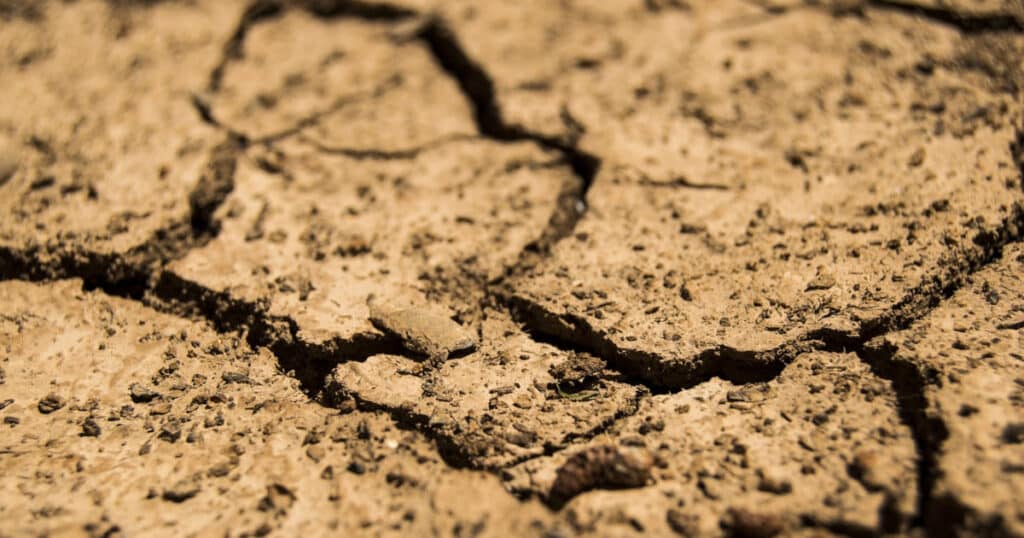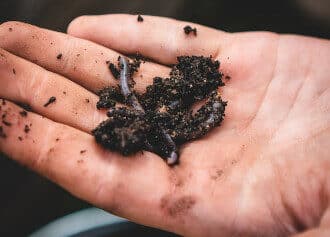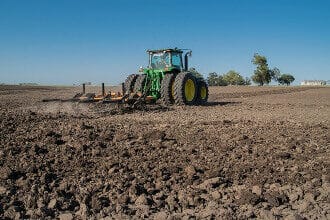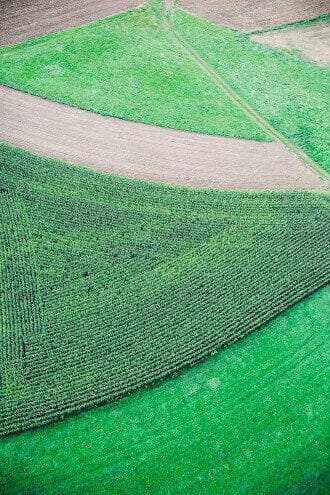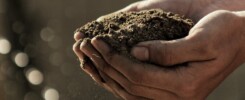By Harry Cooper
Soil is one of the most important parts of our environment. It is essential for plant growth, nutrient cycling, water conservation, and erosion control. In addition to its environmental importance, it is also important for humanity as well; agricultural industries all around the world rely on healthy soil for growing crops.
Like other parts of the natural environment, soil requires being maintained in a healthy state to function. Since soil performs such a wide variety of functions, there are many different attributes of a healthy soil. These can include nutrient availability, presence of organic matter, and physical strength.
In an undisturbed environment, soil is kept healthy and balanced by natural cycles such as the water and nutrient cycles. However, human disturbances such as agriculture and land clearing disrupt and degrade soils. When soil becomes degraded to the point that it can no longer support any plant life, it becomes exhausted. Soil exhaustion, sometimes called soil fatigue, is a major problem that affects many parts of the world reliant on industrial agriculture. However, by using the proper sustainable farming techniques, soil degradation and exhaustion can be prevented, and soils can recover to a healthy productive state.
Why Healthy Soil is Important
Soil provides us with many different essential functions that are necessary for our society and our ecosystems to function. In order to understand just how important protecting our soil is, it is important to understand the different ways in which we benefit from a healthy soil.
Soil Nutrients
Soil is the primary source of nutrients for plants, and a healthy soil must contain an abundant and wide variety of nutrients. The three most important of these nutrients being nitrogen, phosphorus, and potassium. These help plants resist disease, take up energy, and generally grow bigger and stronger.
All of a plant’s nutrients come from the soil. Without a nutrient rich soil, plants are unable to grow. This makes keeping soils healthy and nutrient rich incredibly important for agriculture, conservation, and plants everywhere.
Soil Organisms
Another essential component of a healthy soil is an abundance of soil biodiversity. Organisms in soil including bacteria, fungi, worms, and insects help to decompose organic matter. This process helps filter out pollutants and excess nutrients that would otherwise seep through the soil into bodies of water. The decomposition of organic matter in soils is also helpful in mitigating air pollution as well; by taking in things like carbon and nitrogen, soil organisms help soil sequester it away for long term storage.
Soil Structure
Soil is made up of aggregates, which are various soil particles bound together in clumps. These aggregates need to be made up of a delicate balance of minerals, water, air, and other particles in order to maintain a strong physical structure. Soils with a healthy physical structure are very important for plant roots, movement of microorganisms, water mitigation, and so much more. When a soil loses its healthy structure it becomes susceptible to soil erosion, and can be washed or blown away entirely.
Causes Of Soil Exhaustion
Soil exhaustion is most often caused by harmful human activity. While these soil degrading impacts come primarily from agricultural practices, everyday human activity can also have a large and varied impact on soil health.
Chemical Contaminates
One of the biggest challenges to maintaining soil health is chemical contaminants polluting the soil. This kind of soil pollution can be caused accidentally through run off of harmful chemicals or intentionally by using chemical fertilizers and pesticides that harm the soil.
Both industrial and domestic activities release harmful materials into runoff water that eventually ends up in soil. Common contaminants include heavy metals from roads, petroleum products from cars, and pesticides from yards. When it rains, all these chemicals will flow into the runoff water and contaminate both the water supply and the soil.
Another way that chemical contaminates can get into the soil is through the use of pesticides and fertilizers in agriculture. These chemicals often seep into the soil which kills off organisms in the soil and disrupts the natural production of nutrients. This prevents the soil from performing its natural functions and can often lead to soil exhaustion.
Tillage
Another way that soil becomes degraded is through soil tillage. Tilling is used in agriculture to loosen up soil to make it easier to plant seeds in it although loosening soil in this way also destroys a lot of its quality. Tilling completely rearranges soil structure, making it much looser and more susceptible to erosion.
By disrupting the soil at such a large scale, tilling also destroys the habitat of helpful soil organisms. This ruins a soils ability to cycle nutrients and decompose organic matter. By tilling the land, agricultural soil looses much of its ability to support plant life and perform its other important functions, effectively making it exhausted.
How to Prevent Soil Exhaustion
Soil exhaustion is harmful to both the environment and human development, and it is incredibly important that we do everything in our power to prevent it. One of the most important places that we can reform to prevent soil exhaustion is the agricultural industry.
Soil Friendly Agricultural Practices
Tilling and chemical fertilizers may seem like important for keeping farms bountiful and productive. However, there are actually many alternative methods of farming that are better for soil health, and are also more sustainable.
One adjustment that can be made to traditional farming techniques is the use of crop rotation. Crop rotation involves planting different kinds of crops in different spots each year. When one crop species is planted in one spot, it depletes the specific nutrients needed for it to grow. By switching which crops are planted in which spot each year, it gives the soil time to recover lost nutrients and regain its ability to support a wide variety of plant species.
Another way to maintain healthy soil in agriculture is by utilizing cover crops. Cover crops are plants planted in the off season that leave nutrients in the soil after they are gone. This prevents erosion by keeping the land from being barren and gets rid of the need for harmful chemical fertilizers. There are also many other ways of fertilizing soil without harming it, such as compost, manure, and other organic fertilizers.
Soil Exhaustion and Religion
In many spiritual traditions, soil is linked closely to human fate. There is good scientific/historical reason for this, as Katsuyuki Minami discusses in his article, “Soil and humanity: Culture, civilization, livelihood and health“ how many civilizations have been destroyed because of mismanagement of soil.
The awareness of the importance of soil is found in many indigenous cultures. So important is the soil in these traditions, there must be spirits who exist to protect it and discourage us from abusing the land. Minami gives various examples of “soil spirits” who protect the land:
In Celtic cultures, the spirits of the soil (dei terreni) are spirits of agriculture that make grains yield well and cows give much milk. They are the guardian spirits of farmers. Australian Aborigines feel that harming the land is harming themselves. Communication with the land by the ancients was based on a totally different perception from that of the present. In Switzerland spirits called gnomes, who look like small old men, were believed to dwell in the soil. According to the Swiss alchemist Paracelsus (AD 1493–1541), they represent one of the four elements (earth, water, wind and fire). Soil-related spirits are also common throughout Asia. Examples are the Ainu kamui, the Ryukyu nirai kanaii, China’s tiandi, Thailand’s phi, and the Philippines’anito.
With all our scientific advancement, we’ve blinded ourselves to one of the most basic truths of indigenous wisdom, soil is the source of our life. Destroying the soil, we destroy ourselves. Saving the soil, we save our future.
* Featured image source

